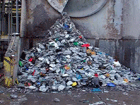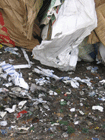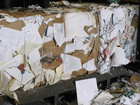


Single Stream Recycling
Best Practices
Single Stream Best Practices Manual and Implementation Guide by Susan Kinsella, Conservatree and Richard Gertman, Environmental Planning Consultants January 2007 |
||||
The Single Stream Recycling Best Practices Manual and the Best Practices Implementation Guide are designed to help recycling managers create and maintain the best program for their goals and local community, as well as for the health of the whole recycling system. Recommendations are directed towards solving problems and maximizing the benefits of this type of recycling program. Many community recycling programs, recycling collectors and manufacturers want the increased quantities of recovered materials promised by single stream collection programs. But without high quality processing, "increased quantity" is meaningless. Too many bales of recovered materials are arriving at manufacturing plants with high contamination levels such as shown below. The Manual and Guide identify problem points in the system and recommend solutions.
Click on an image to the right for a larger view.
Choose the version below that gives the level of information you want. |
 |
|||
 |
||||
 |
||||
|
Summary only - 8 pages |
Single Stream Best Practices Manual Key points - 56 pages |
Single Stream Best Practices Implementation Guide Includes all the Manual information plus additional explanations, discussions, examples, appendices -104 pages
|
Single Stream Workshop |
Resource Recycling Magazine Article |
EXECUTIVE SUMMARYRecycling is a dynamic system that is continually evolving to embrace new opportunities and address new challenges. Over the past five years, it has changed dramatically as collectors have introduced innovations and new collection efficiencies in the form of single stream recycling programs. These innovations are very popular with an increasing number of communities, rapidly growing to at least 500 programs. Local governments cite many recycling benefits derived from switching to single stream collection, including multiplying the volume of recovered materials, boosting the diversion rate from the local landfill, increasing recycling participation by residents and businesses, and reducing collection costs. Many communities also welcome the opportunity to add new categories of materials to their single stream programs, such as mixed paper. Some are even able to start additional separate collection programs, such as green waste, because single stream’s collection efficiency frees up trucks and personnel. Single stream programs cover a wide range of options, but most communities particularly appreciate that commingling the recovered materials allows for automated recycling collection. While some single stream programs continue to use manual collection of multi-bin systems, those that have switched to automated wheeled cart collection have gained significant cost savings through reducing worker injury rates and workers compensation costs. However, the introduction of single stream collection systems has not had such uniformly positive results for recycled product manufacturers. Instead, it has accelerated an already pronounced slide towards poorly sorted recovered materials, with glass, plastics and metals being delivered to paper mills in bales of fiber, the wrong types of fiber going to paper mills that can only use specific grades, and increased contamination, as well as materials lost to plastics, glass and aluminum manufacturers. Recyclable materials that were recovered for recycling in community programs but then sent to the wrong types of manufacturers generally end up in landfills near the mills. In other words, poor processing trashes recyclables. Manufacturers have seen their costs increase significantly for cleaning and screening the poorly-processed materials, repairing damage to equipment, more frequently cleaning and replacing equipment, purchasing new raw materials to replace those that were unusable, and landfilling the recyclable materials they cannot use. While more than 75% of recovered materials from many single stream curbside programs are paper fiber, the problems created by delivery of poorly sorted recovered materials affect all recycling manufacturers. Glass and paper fibers mixed in with the plastics, or ceramics and plastics mixed into the glass, or glass mixed with aluminum cans all present serious problems for those manufacturers. Not only do these unsuitable materials cause damage and increase costs for the mill they are sent to, they also represent significant losses to their own materials industries, which need them for their own recycling production. Yet manufacturers who use recovered materials remain optimistic about the potential for single stream programs to increase the volume of materials available to them, once the quality issues are solved. Processing: Still Catching Up To Collection Changes Poor quality recyclable materials result from the challenge for processing facilities in separating highly commingled recyclables back into their original separate material types, appropriate for each of their markets. Single stream innovations were first introduced by collection companies, and collection is where the efficiencies and cost savings are concentrated. Recycling processing facilities are still experimenting with their design and functioning to determine how best to take apart the mix of materials that single stream collection puts together. This dilemma has historical roots. The development of single stream programs coincided with changes in economic signals affecting recycling markets as more local governments in the U.S. and Canada provided curbside recycling collection programs to their residents. Earlier, when brokers collected and sold only high value recovered materials, manufacturers could control the volume and quality through price signals. They increased the prices they paid when they needed more volume or higher quality and lowered the price when they had too much volume. But once curbside collection programs started, the volume of recovered materials was continuous, with no reference anymore to price signals. This changed recycling from demand-side markets to supply-side markets, where materials are collected to keep them out of landfills, not in response to market needs. Recycling Requires Collaboration This Single Stream Best Practices Manual and its companion Single Stream Best Practices Implementation Guide include extensive discussions about processing. However, every part of the recycling system plays an essential role in ensuring that single stream fulfills its potential to benefit the whole system. The recycling cycle represents a collaborative system, and no one sector can operate independently of the others. The success of recycled product manufacturers depends on the success of processors to properly sort the materials they receive. Processors, in turn, depend on collectors to pick up loads of recyclables from residents who understand what should go into their recycling carts and what should not. Problems in any part of the system require resolution or ultimately every sector suffers, even those that originally benefited. Receiving poorly sorted materials from a processor discourages manufacturers from investing in new or expanded recycled product manufacturing capacity and even may cause some to close or return to using raw virgin resources. Low quality recovered materials can lead to defects in finished products, which threaten buyers’ acceptance of recycled products. If customers, whether industrial or consumer, do not buy products with recycled content, losses cascade back through the system. Quality problems with some recycled products may taint buyers acceptance of other recycled products, as well. Any of these outcomes will ultimately threaten markets for the materials recovered in community recycling programs. So all recyclers have a stake in making sure that single stream recycling works as well for manufacturers and processors as it does for collectors. Additionally, recyclers must ensure that recovered materials are usable by a wide range of recycled product manufacturers, not just those that make the limited number of products that can use commingled materials or those that can afford the labor costs of re-processing the recovered materials. Poorly processed materials particularly undermine domestic recycled product manufacturing and many of the types of recycled products that produce the greatest conservation benefits. In designing a single stream program around best practices, the following points are essential to integrate. Recycling choices must be made in the context of the whole system, not just one sector. While single stream lowers costs for collection, it increases costs for processors and manufacturers. The potential increased volume can still make the added costs worthwhile, but only if collectors ensure the optimal functioning of the other sectors, as well. Recycling should be implemented as a resource management system, not a waste management system. Too often, recycling has been considered an “add-on” to a long-standing garbage collection program and therefore has been expected to pay its own way. Garbage collection, however, does not include the same financial requirements, since it is supported by user fees or local taxes. Commonly, this has led to all new costs being assigned to the recycling program, but all the savings assumed to accrue to the garbage collection system, even when many of those savings were produced by the increased recycling. In a resource management system, recycling is recognized as the centerpiece for managing residents’ discards. Garbage is secondary and only constitutes what has not been recycled. Modern recycling collects feedstock materials for manufacturing systems, and therefore must effectively support manufacturers’ needs to meet demanding production specifications. When collection is focused primarily on garbage, there are few quality requirements for materials that are landfilled. But since over half the discards from residential and commercial sources are recyclable, collection focus must shift to quality requirements that support recycled product manufacturing. Savings made through improved efficiencies in collection, such as those in single stream programs, must be invested in high quality processing that can meet a wide range of manufacturers' requirements. Collection is not recycling. Most of the public, and even many community recycling program managers, consider materials to be “recycled” once they are collected. This reflects the close relationship recycling program managers have with the collectors who work with them every day. But in reality, materials are not actually “recycled” until they are made into new products. So local recycling programs should be designed to maximize their materials’ use in manufacturing. “Diversion” is not recycling. Diversion from landfills has become a major driver for many recycling programs, with some states and municipalities even operating under legislative requirements for achieving specific diversion goals. However, when poorly sorted materials are counted as “diverted” from local landfills but end up landfilled by manufacturers because they were not usable, they simply made a longer trip to the landfill and are not really diverted. This is not a responsible outcome for “diversion.” Rather, community recycling programs should incorporate data about the fate of their materials into calculating their diversion rate. They should know how much of their materials were actually usable, and also how much of the use resulted in continuously recyclable products. Manufacturers can provide reports on “millage loss” to processors and community recycling program managers in order to more accurately determine a true diversion rate. Local governments must set the goals and standards that will achieve a sustainable, healthy recycling system. It is important for each recycling business to be economically successful because that ensures the recycling system’s health and longevity. But that, in itself, is only the means, not the goal, of recycling. Rather, community recycling programs were developed to enhance public interest goals for conserving natural resources, water and energy, and strengthening environmental quality – values that sheer economic forces are not comprehensive enough to take into account. Municipal governments are the only participants in community recycling systems that hold enough of the broad expanse of the public's and recycling’s universal interests to consistently drive the system to its highest potential. In order to ensure an optimally functioning whole recycling system, local governments must provide for recycling services that sustain all parts of the cycle, not just collection. Therefore, in the same way that local governments specify collection service requirements, they should also specify processing and marketing requirements, with input and feedback from the industries that will use the recovered resources in the manufacture of new products. Communities that accept processing that produces poorly sorted materials, even if there are markets for them, undermine the health of the recycling system. Recycled product manufacturers need to meet increasingly stringent specifications to satisfy the quality demands of their customers. Processors and collectors should make sure they produce the quality of materials manufacturers need to do it. Well-sorted recovered materials expand recycling markets. High quality sorted materials can be sold to a wide diversity of markets and support the whole range of products that can be made with recovered materials. Many sorted materials can be directed into products that can be recycled multiple times, producing conservation benefits and savings many times over. This is true "diversion" — ensuring that the materials take many steps away from the landfill by being able to be repeatedly recycled. Commingled materials have limited markets because most recycled products can use only certain categories of materials for production. For example, while commingled plastics can be used for many types of plastic lumber, other recycled content plastics products such as fiberfill, carpets, and plastic bags require a single type of plastic resin and cannot use others. Mixed fibers can be used to make paperboard boxes, the inner portion of corrugated boxes, shingles, and stiffening board products such as notepad backings and binder construction, but many other paper products require specific fiber streams only. Mixed fibers, for example, cannot be used to make newsprint, tissue products, printing and office papers, corrugated linerboard (the outside layers of corrugated boxes), or the printing surfaces for paperboard boxes (such as cereal boxes). But, other than tissue, these products are some of the most recyclable — not only can they be made with high percentages of recycled content, but they can also be recycled many times, further extending and multiplying the conservation and environmental benefits. Producing high quality recovered materials allows and encourages the expansion of products and manufacturers that can use recycled content, promoting healthier and more reliable markets for community recycling programs. Similarly, the goal of recycling programs should be to maximize the recyclability of all its materials. While glass, for example, makes up a comparatively small percentage of recovered materials, it should not be wasted on a one-way trip as landfill daily cover or roadbase, when it could have been recycled infinitely as new glass bottles. Build consultation and feedback loops from recycled product manufactures into recycling programs, including not only the manufacturers that currently buy the materials, but also those that would like to buy them if they were properly prepared. Recycling program managers should consult with manufacturers when they are designing or changing their programs, when they design and build a MRF, and as they regularly evaluate the operation of the processing facility and their entire program. A Vibrant Recycling System Is Essential Demand for consumer products is rapidly growing throughout the world and developing countries are building manufacturing plants at rates that are outstripping the sustainable use of raw materials. Recycling is increasingly critical as the foundation for sustainable production. Single stream collection programs promise to provide the increased quantities of recovered materials needed for this increased production. But the increased volumes are only favorable if they are usable by the production industries. Recycling has to play a leading role in creating more environmentally sustainable manufacturing methods. It can only do that if recyclers step back, look at how best to encourage a vibrant, complete recycling system, and make sure that the changes made now will serve the promise of recycling both now and also in the future. Leading organizations representing every part of the recycling cycle contributed to the development of this Single Stream Best Practices Manual and Implementation Guide, including the California Department of Conservation, the American Forest & Paper Association, the American Plastics Council, the Glass Packaging Institute, the Alameda County Source Reduction and Recycling Board, GreenWaste Recovery, the Forest Products Association of Canada, and the Sonoma County Waste Management Agency. They, and many more, also generously offered their time and expertise to give us tours, talk through ideas, and review drafts of the Manual. EPA-Region 9, the Whole Systems Foundation, and the Martin-Fabert Foundation supported development of the California Single Stream Roundtable in 2005 and publication of its results afterwards. All of these organizations participated because, while they have many different stakes in the recycling system, ultimately they all appreciate the potential for new dynamism in recycling if increased quantities of recovered materials can be combined with the quality that manufacturers need. This Best Practices Manual and Implementation Guide is dedicated to helping community recycling programs fulfill that promise. |
||||
Conservatree is a project of SEE - Social and Environmental Entrepreneurs. Copyright 1988-2008 Conservatree. Terms of Use